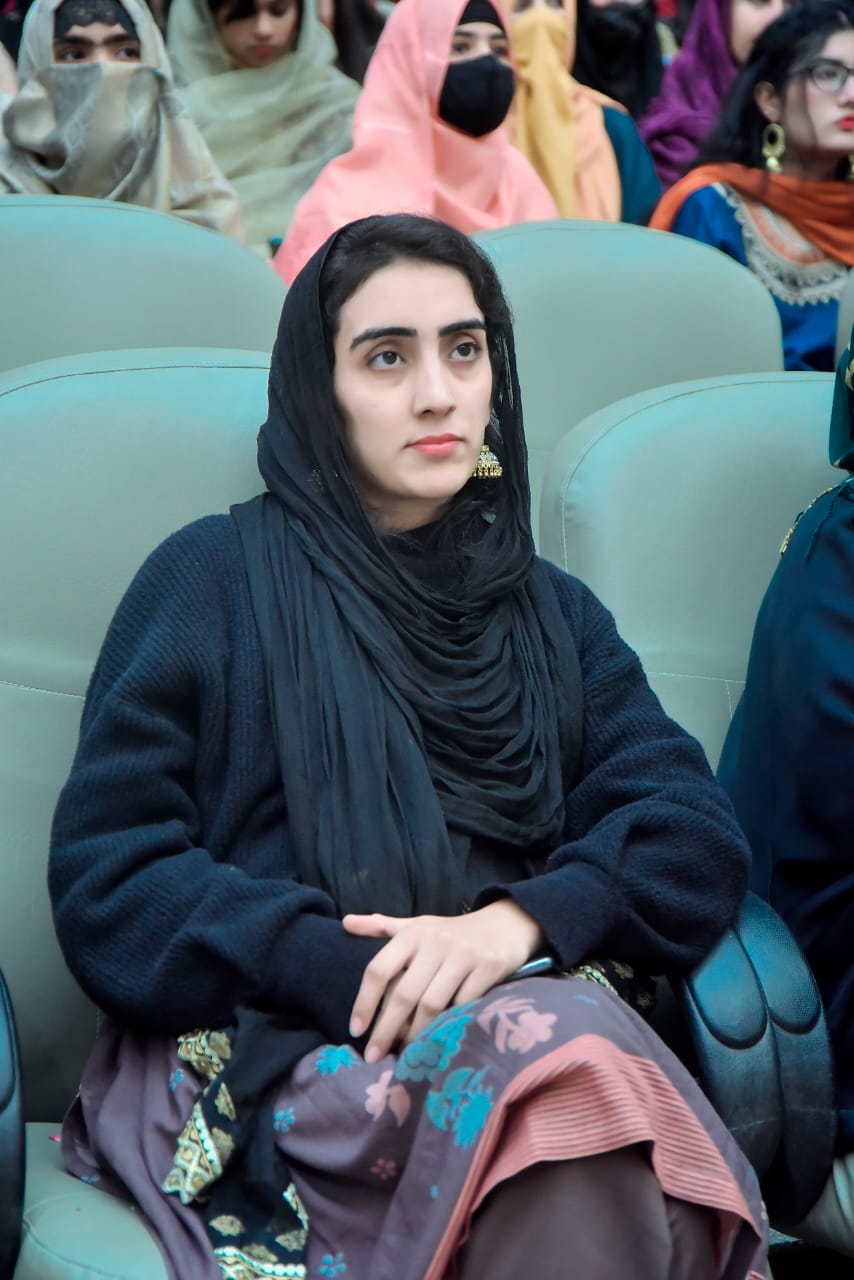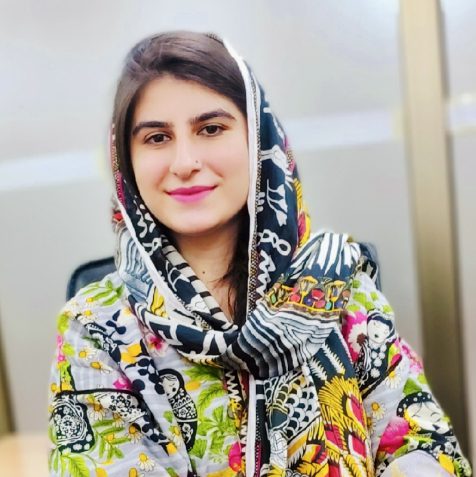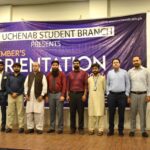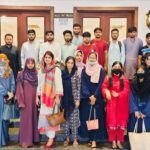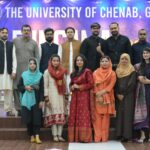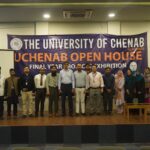Bachelor's
BS Electronics and Computing
Duration
4 years full-time
Qualification
Bachelor of Science in Electronics and Computing
Academic Session
Spring and Fall
Life at UChenab
The Bachelor of Science in Electronics and Computing is a four-year undergraduate program that bridges the gap between modern electronics and advanced computing technologies. This interdisciplinary degree equips students with a strong foundation in electronic circuit design, embedded systems, computer programming, artificial intelligence, and data processing.
As the world becomes increasingly digital and connected, professionals who understand both hardware and software are in high demand. This program is designed to produce graduates capable of innovating and contributing to fields such as IoT, robotics, smart systems, cloud computing, automation, and data-driven electronics.
Students benefit from hands-on training in advanced laboratories, access to real-world industry tools, and mentorship by experienced faculty. The University of Chenab provides a stimulating learning environment where students evolve into technically skilled, problem-solving professionals ready for careers in cutting-edge industries.
- 12 years of education, Higher Secondary School Certificate/Intermediate, F. Sc or ICS or DAE (in relevant field) with 45%.
- Passinstitutional admission test with 50%
Duration
Minimum: 4 years (8 regular semesters)
Maximum: 6 years (12 regular semesters)
The maximum limit is further extendable in accordance with HEC semester rules.
Department of Electronics & Computing
Fee Structure Fall 2025
BS Electronics & Computing (BSEC)
| Category | Details |
|---|---|
| Semester | First |
| Courses | 7 |
| Credit Hours | 18 |
| Tuition Fee/Cr. Hr. | 4,700 |
| Tuition Fee/Semester | 84,600 |
| Enrollment Fee | 3,500 |
| Examination Fee | 3,500 |
| Medical Diagnostic Charge | 500 |
| Societies & Club Fee | 2,500 |
| Total Semester Fee | 94,600 |
| Semester | Second |
| Courses | 7 |
| Credit Hours | 18 |
| Tuition Fee/Cr. Hr. | 4,700 |
| Tuition Fee/Semester | 84,600 |
| Enrollment Fee | 3,500 |
| Examination Fee | 3,500 |
| Medical Diagnostic Charge | 500 |
| Societies & Club Fee | 2,500 |
| Total Semester Fee | 94,600 |
| Semester | Third |
| Courses | 8 |
| Credit Hours | 18 |
| Tuition Fee/Cr. Hr. | 4,800 |
| Tuition Fee/Semester | 86,400 |
| Enrollment Fee | 4,000 |
| Examination Fee | 4,000 |
| Medical Diagnostic Charge | 500 |
| Societies & Club Fee | 2,500 |
| Total Semester Fee | 97,400 |
| Semester | Fourth |
| Courses | 6 |
| Credit Hours | 16 |
| Tuition Fee/Cr. Hr. | 4,800 |
| Tuition Fee/Semester | 76,800 |
| Enrollment Fee | 3,000 |
| Examination Fee | 3,000 |
| Medical Diagnostic Charge | 500 |
| Societies & Club Fee | 2,500 |
| Total Semester Fee | 85,800 |
| Semester | Fifth |
| Courses | 7 |
| Credit Hours | 18 |
| Tuition Fee/Cr. Hr. | 4,900 |
| Tuition Fee/Semester | 88,200 |
| Enrollment Fee | 3,500 |
| Examination Fee | 3,500 |
| Medical Diagnostic Charge | 500 |
| Societies & Club Fee | 2,500 |
| Total Semester Fee | 98,200 |
| Semester | Sixth |
| Courses | 9 |
| Credit Hours | 16 |
| Tuition Fee/Cr. Hr. | 4,900 |
| Tuition Fee/Semester | 78,400 |
| Enrollment Fee | 4,500 |
| Examination Fee | 4,500 |
| Medical Diagnostic Charge | 500 |
| Societies & Club Fee | 2,500 |
| Total Semester Fee | 90,400 |
| Semester | Seventh |
| Courses | 6 |
| Credit Hours | 15 |
| Tuition Fee/Cr. Hr. | 5,000 |
| Tuition Fee/Semester | 75,000 |
| Enrollment Fee | 3,000 |
| Examination Fee | 3,000 |
| Medical Diagnostic Charge | 500 |
| Societies & Club Fee | 2,500 |
| Total Semester Fee | 84,000 |
| Semester | Eighth |
| Courses | 7 |
| Credit Hours | 15 |
| Tuition Fee/Cr. Hr. | 5,000 |
| Tuition Fee/Semester | 75,000 |
| Enrollment Fee | 3,500 |
| Examination Fee | 3,500 |
| Medical Diagnostic Charge | 500 |
| Societies & Club Fee | 2,500 |
| Total Semester Fee | 85,000 |
| Total Semesters Fee | 730,000 |
| Registration Fee (Non Refundable) | 20,000 |
| Total Fee | 750,000 |
1. General Principles
The BS Electronics and Computing program integrates theory with application through lectures, hands-on labs, and collaborative projects. Students are encouraged to become independent learners and critical thinkers while gaining exposure to real-world technologies and systems.
2. Teaching Sessions
Teaching methods include interactive lectures, lab-based experiments, coding sessions, project workshops, and technical presentations. Students also participate in industry guest talks, innovation boot camps, and interdisciplinary seminars.
3. Teaching Schedule
The departmental teaching schedule includes:
- Delivering lectures: Daily
- Presentations: Twice a month
- Quiz-based activities: Twice a month
- Research work/Practicals: Once a week
- Interdepartmental meetings: Once a month
- Guest lectures: Conducted from time to time
- Library-based assignments: Conducted from time to time
Note:
- All academic sessions are conducted by highly qualified and trained faculty.
- A minimum of 75% attendance is required to be eligible for final examinations.
- The Quality Assurance Department monitors academic standards regularly.
Structured evaluations ensure continuous improvement in course delivery and learning outcomes.
Assessment methods include theoretical exams, lab reports, practical evaluations, coding assignments, term projects, and final-year design projects. Students must pass both the theoretical and practical components of each course with a minimum of 50% marks in each category.
Graduates of BS Electronics and Computing are highly sought after in both local and international technology markets. They possess a diverse skill set that allows them to work in industries spanning electronics design, computing, automation, AI, and telecommunications.
Career pathways include:
- Embedded Systems Engineer
- Software Developer
- IoT Specialist
- Robotics Engineer
- Network Systems Administrator
- Artificial Intelligence Engineer
- Cloud Computing Analyst
- Mobile and Web App Developer
- Automation Specialist
- Research and Development Engineer
- Defense and Aerospace Technology Expert
- Employment opportunities in the Middle East, Europe, North America, and beyond
Graduates may also pursue advanced studies such as MS, MPhil, or PhD in fields like Electronics Engineering, Computer Science, Data Science, or AI.
Helping you find the right career
At the University of Chenab, students receive extensive career development support through the Office of Student Affairs. From internship placements to job application training, students gain access to employer networks, industry collaborations, and career fairs to help them transition successfully into the workforce.
Our vision is to be an international partner in computing education, research and development. Well, our graduates should be impacting society as computing professionals and entrepreneurs should highlight professional integrity and leadership.
Department works with a clear mission to provide the country with trained resources. High-tech products and services are available to exercise commercialization through incubation of high-tech companies.
- To produce best quality Computer Science & IT professionals and researchers by providing state-of-the-art training, hands on experience, and healthy research environment.
- Collaborate with industry and academia around the globe for achieving quality technical education and excellence in research through active participation of all the stakeholders.
- To promote academic growth by establishing Center of Excellences as well as offering inter-disciplinary postgraduate and doctoral programs.
- Establish and maintain an effective operational environment and deliver quality, prompt, cost effective and reliable technology services to the society as well as compliment the local and global economic goals.
- Making world class technology available to undertake large and complex IT Projects in Pakistan
- Exercising commercialization through incubation of high tech companies.
Currently, the Department is offering the following undergraduate and postgraduate degree programs:
2024
Ejaz, S., Baig, R., Ashraf, Z., Alnfiai, M. M., Alnahari, M. M., & Alotaibi, R. M. (2024). A deep learning framework for the early detection of multi-retinal diseases. PLOS ONE, 19(7), e0307317.
Shaukat, F., Ejaz, N., Ashraf, Z., Alnfiai, M. M., Alnahari, M. M., & Alotaibi, R. M. (2024). GenVis: Visualizing Genre Detection in Movie Trailers for Enhanced Understanding. IEEE Access.
Ashraf, Z., Sohail, A., & Iqbal, M. (2024). Design and Implementation of Lightweight Certificateless Secure Communication Scheme on Industrial NFV-Based IPv6 Virtual Networks. Electronics, 13(13), 2649.
Mahmood, Z., Ashraf, Z., Iqbal, M., & Farooq, B. (2024). User-trust centric lightweight access control for smart IoT crowd sensing applications in healthcare systems. Personal and Ubiquitous Computing, 28(2), pp. 1-14.
2023
Ashraf, Z., Sohail, A., Hameed, A., Farhan, M., Alotaibi, F. A., & Alnfiai, M. M. (2023). Robust and Lightweight Remote User Authentication Mechanism for Next-Generation IoT-based Smart Home. IEEE Access 11, pp. 137899 – 137910
Ashraf, Z., Mahmood, Z., & Iqbal, M. (2023). Lightweight Privacy-Preserving Remote User Authentication and Key Agreement Protocol for Next-Generation IoT-Based Smart Healthcare. Future Internet, 15(12), 386.
Ashraf, Z., Sohail, A., & Yousaf, M. (2023). Lightweight and authentic symmetric session key cryptosystem for client–server mobile communication. The Journal of Supercomputing, 1-25.
Ashraf, Z., Sohail, A., & Yousaf, M. (2023). Robust and lightweight symmetric key exchange algorithm for next-generation IoE. Internet of Things, 22, 100703.
Ashraf, Z., Sohail, A., Latif, S. A., Pitafi, A. H., & Malik, M. Y. (2023). Challenges and Mitigation Strategies for Transition from IPv4 Network to Virtualized Next-Generation IPv6 Network. Int. Arab J. Inf. Technol., 20(1), 78-91.
Butt, U. M., Arif, R., Letchmunan, S., Malik, B. H., & Butt, M. A. (2023). Feature Enhanced Stacked Auto Encoder for Diseases Detection in Brain MRI. Computers, Materials & Continua, 76(2).
Ikram, A., Butt, M. A., & Tariq, I. (2023). Comparative Analysis of Regression Algorithms used to Predict the Sales of Big Marts. Journal of Innovative Computing and Emerging Technologies, 3(1).
Butt, M. A., Danjuma, S., Ilyas, M. S. B., Butt, U. M., Shahid, M., & Tariq, I. (2023). Demand Prediction on Bike Sharing Data Using Regression Analysis Approach. Journal of Innovative Computing and Emerging Technologies, 3(1).
2022
Butt, U. M., Ullah, H. A., Letchmunan, S., Tariq, I., Hassan, F. H., & Koh, T. W. (2023). Leveraging Transfer Learning for Spatio-Temporal Human Activity Recognition from Video Sequences. Computers, Materials & Continua, 74(3).
Butt, U. M., Letchmunan, S., Hassan, F. H., & Koh, T. W. (2022). Hybrid of deep learning and exponential smoothing for enhancing crime forecasting accuracy. Plos one, 17(9), e0274172.
Baig, R., Rehman, A., Almuhaimeed, A., Alzahrani, A., & Rauf, H. T. (2022). Detecting malignant leukemia cells using microscopic blood smear images: a deep learning approach. Applied Sciences, 12(13), 6317.
Fatima, M., Rextin, A., Nasim, M., & Yusuf, O. (2022, October). Digital Information Seeking and Sharing Behaviour During the COVID-19 Pandemic in Pakistan. In Multidisciplinary International Symposium on Disinformation in Open Online Media (pp. 44-62). Cham: Springer International Publishing.
Prince Sultan University, Riyadh, Saudi Arabia
King Saud University, Riyadh, Saudi Arabia
Taif University, Taif, Saudi Arabia
- University of Kotli, Kotli, Azad Jammu & Kashmir
- IQRA University, Islamabad Campus, Islamabad
- RIPHAH University, Islamabad Campus, Islamabad
- COMSATS University, Sahiwal Campus, Sahiwal

Department of computer science has built strong linkage with industry and signed various MOUs with different software houses for jobs and internships.
Recently the University of Chenab has signed MOUs with following software houses.
- KMS Enterprise Solutions in Canada
- Techno Verse
- Twin Spider
- Dev Valley
- Cipher Coders
- Soft Pin
- Huawei ICT Academy
- Gujrat Chamber of Commerce and Industries
Lead By
Ambience
Peaceful ambience, agile teaching as well as non-teaching staff, and a disciplined yet enjoyable and motivating atmosphere. Welcome to the University of Chenab. We produce professionals who are adept in their disciplines. Our institution is not only concerned with grades and education, but also take care of mental well-being of our students.The University of Chenab
Our Mission
The University of Chenab represents excellence in teaching, research, scholarship, creativity and engagement. Its mission is to produce professionals outfitted with the highest standards in creativity, transfer and application of knowledge dissemination to address issues of our time.
The UChenab sculpts its graduates to become future leaders in their fields to inspire the next generation and to advance ideas that benefit the world.
The University of Chenab
Our Vision
Recognization
The University of Chenab, Gujrat aspires to become a nationally and internationally recognized university that distinguishes itself as an embedding center for outstanding ethical and moral values, teaching quality, learning outcomes, and richness of the student experience. The University of Chenab, Gujrat envisions a transformative impact on society through its continual innovation in education, creativity, research, and entrepreneurship.Finding Your
Course
How to Apply?
- Visit (Website link admission tab) and search your respective course and department on this website.
- Check the admission criteria and learn about the eligibility criteria of your selected course.
- If you are confused about the fee structure visit our fee guide at (link)
- To search more about the campus and studies visit other events and tabs to learn about the latest news and events.
- Still if there are any ambiguities then contact our admission office.
Apply Online
- Search the page and select your course scroll to the menu and click on and option ‘Apply.’
- Fill the online application form with the required attachments.
- After the form is submitted then you’ll receive a confirmation email. Confirm your application which is then processed forward.
- After the acceptance of the online registration a date and time is allocated for an in-campus test.
- You must bring your original attested documents on your test day.
- After sometimes the results are out so constantly check your email for the notification.
- Visit the campus for enrolment.
- After the enrolment attend your orientation day as it is an interactive session among students and the faculty.
- Then, receive your timetable.
- Finally, start a new step of your carrier.








